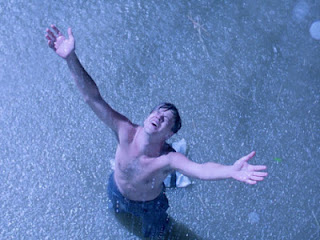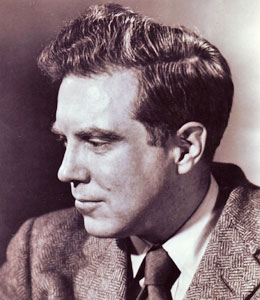Last month I read a book about Howard Hughes [Hack, Richard. Hughes. The Private Diaries, Memos and Letters. The Definitive Biography of the First American Billionaire. Beverly Hills: New Millennium Press. 2001]. Ordinarily, I don't read biographies of the rich and famous. Vicarious curiosity that the public holds for its fame-encrusted figure-heads I tend to regard with disdain. But I thought it might be diverting to see how a biography could be framed through the use of "memos"--particularly since the shadowy, secluded subject used inter-organizational memos during the last decades of his life to engineer nearly all of the business and personal transactions he conducted.
![]()
The outward events of Hughes's biography are generally known by now. Hack, the author, gives fairly short shrift to the early years of Hughes's life, preferring to concentrate on the middle and later periods, when his subject's behavior became not just a focus of the most lurid kinds of gossip-columnist speculation, but a matter of national security. Born into a rich family built upon the successful invention by his father of a petroleum well-drilling-bit device, Hughes might have spent the rest of his days basking in the accumulated wealth of the family corporation.
An indifferent student in school, he nevertheless showed early on that he had engineering aptitude. Inheriting his Father's fortune at the tender age of 19, he set about at once to exploit his interests and ambitions in the field of experimental aviation, and in the movie production business--both industries then in their infancy.
Hughes made brilliant innovations in the field of modern aircraft design, in large measure to facilitate his personal ambition to achieve preeminence as a speed-setting pilot--all of course financed through his personal fortune. His management of his movie company was initially at least as successful as his competitors, as he produced a number of very successful films that were considered benchmark successes in their day (i.e., Front Page --1931 [one of my all-time favorites, with Adolph Menjou and Pat O'Brien], Hell's Angels [1930] and Scarface [1932].
It isn't difficult to see how a young rich boy might become overwhelmed by his own good fortune and midas touch, and that's just what happened to Hughes. With each plateau of accomplishment, his ego doubled in size. Along with his ambition, he developed a ruthlessly efficient financial acumen, turning untenable debt into undreamed of profits, selling off assets and investing in new ones with astonishing aplomb. After his first failed marriage, he became a relentless philanderer, sweeping gullible ingenues off their feet with promises of riches, then quickly abandoning them after a quick conquest.
As his wealth grew, his influence in the aviation industry grew right along with it. Encouraged by the publicity he gained from his successful world-record-setting prototype racing planes, he parlayed his connections into big contracts with the government during WWII. He was heavily involved in the early development of commercial (passenger) aviation as well (TWA, Hughes Aircraft), and later Hughes Aerospace Group.
However, as early as the late 1930's, Hughes had begun to exhibit worrisome symptoms of obsessive-compulsive behavior. He would segregate batches of peas, for instance, according to size, agonizing over insignificant details to a maddening degree. During his tenure as the controlling shareholder of RKO studios, for instance, he held up production of his latest Jane Russell potboiler for weeks while he had a different brassier designed for his well-endowed starlet.
![]()
The special combination of vast wealth, ambition, power, desire and contempt for other people is not unique in history, of course. One could say, without much exaggeration, that Hughes was a later incarnation of the Robber Baron of the Gilded Age in American business, an American version of the enlightened gentry, partly a prince of endowed means, partly a self-made man. What set him apart from the other business-types of that class, such as Ford, Rockefeller, Buffett, Gates, etc., was his derring-do, the lust for adventure (in aviation). Great wealth may make someone cautious, or brashly impulsive--the common thread is an anxiety that one may lose it all, leading to elaborate security measures, checks and balances, and a lack of trust in nearly everyone, leading to a condition of isolation. On the basis of his fame, and wealth, and decisive management style, one might say that he had a strong ego structure, that of a confident loner, selfish and driven to excel.
![]()
The Hughes H-1 racing airplane partly designed and commissioned by Hughes, with which he set the world land speed record of 352 mph in 1935
And yet, Hughes was a fragile character. Following a bad plane crash in Los Angeles in 1946, Hughes had a difficult recuperation, suffering from serious internal injuries from which he never fully recovered. During the recuperation period--which doctors at the time thought miraculous--he developed a dependency on pain-killers, particularly codeine, which he continued to use, in increasing amounts via direct muscle injection, for the rest of his life. His physical fragility following these injuries affected his judgment, and led to long periods of psychological withdrawal, during which he ate little and would watch movies over and over again. He developed paranoid obsessions about personal hygiene, diet, secluding himself and communicating with the outside world via a small group of select lieutenants and body-guards.
Hughes testifying before a Congressional subcommittee investigating charges regarding his misuse of federal contract money
In the management of his vast holdings, he became increasingly impulsive and irrational. He bought up franchise chains in Texas, on a whim. He acquired several large hotels and casinos in Las Vegas. Confined to penthouse suites in large hotels, he sat surrounded by boxes of Kleenex, naked, with a towel draped over his lap, writing elaborate memoranda on yellow legal pads which he handed on to aids, detailing his orders and requirements.
Though it is unclear what would have caused such extreme paranoia in one with his great freedom and power, irrational insecurity seems to be the cause. Unable to make meaningful connections to other people--lovers, associates, friends--he fell into a state of static immobility, in which the external world of his financial empire became less and less real. The fictional realm of movies--of directed narrative--became more and more important to him, and he came to see his life as a series of moral crises and challenges which he could manipulate from behind the curtain of his isolation, inside an empire of his own design. He seems to have had an inkling of how peculiar his life had become, since he went to some pains to make as few public appearances as possible during the 1950's, and understood the potential embarrassment that his obvious deterioration would cause, were it become widely known. No one seems to know whether this was a style of life that he actually preferred, or one which--as with classically disturbed individuals--he couldn't escape. The dilemma was exacerbated by the fact that given his great power over his subordinates, there was no one to challenge the course of his descent.
![]()
Leonardo DeCaprio--playing Hughes in the Martin Scorcese movie Aviator--looks a bit like young Cassius Clay
Ironically, as the value of his holdings and influence over political events--through secret bribes and pay-offs etc.--grew, his physical presence in the world declined. There's a peculiar passivity about his manipulating vast sums of money and literally changing the economic landscape in certain parts of the world from a position of such pathetic physical vulnerability--a figure who could buy and sell large swaths of whole cities if he chose, needing to be carried from one place to another in a makeshift stretcher, because he'd become too weak and fragile to walk. It's like a fantasist, trapped in a masturbatory swoon, dreaming of majestic feats and harrowing intrepid escapades. Not unlike how people nowadays spend countless hours engaged in computer games, preferring the animated interior world of virtual reality to real life.
By the 1960's, he had become so long insulated from reality that it had literally changed around him. And yet he continued to work his will through his trusted business officers, whose consternation and frustration with his increasingly scatterbrained orders led to resignations, as well as schemes to divert some of his wealth from under his nose.
The so-called "Spruce Goose" or H-4 Hercules, originally intended to be a transport seaplane to ferry soldiers and materiel across the Atlantic to the European Theater was not completed until after the war, and remains today as an odd obsolete relic. Oversized, fragile and inefficient, it could never have accomplished the tasks for which it was designed.
Nearing the end of his life, he began to move restlessly from one venue to another, around the world, always occupying the penthouse suite of a large hotel, as his body shrank to to a skeleton. As his paranoia got worse, he refused to let anyone even approach him except under the most controlled conditions, leaving many of the important decisions about his empire to a single individual.
Ernest Hemingway suffered a similar kind of deterioration after his airplane crashes in Africa (and other injuries) in the early 1950's. He began to drink more heavily than ever, and eventually submitted to psychiatric treatments at the Mayo Clinic, including shock treatment and pain killing drugs. The depression which led to his suicide has traditionally been assigned to his frustration at no longer being able to write, but subsequent revelations about his literary production throughout the '50's prove that this was not the case. The continuing pain from his skeletal and internal and head injuries would have turned almost anyone else into a bed-ridden recluse, and yet Hemingway remained active physically and socially to the end. The "suicidal" tendencies may have been the simple result of agonizing pain and a realization that he would never again be able to pursue the sporting life--which had been the primary driver of his imagination--again. Hemingway, suffering from his recent injuries, sent his acceptance speech for the Nobel Prize to Stockholm, emphasizing the writer's "lonely" position--the isolation which he seems to have shared with Hughes.
Reading over the accumulated memos and notes Hughes wrote during the last decades of his life must have been a sad task. Hack's biography is not very penetrating, but he seems to get all the facts straight, something that--given Hughes's penchant for secrecy and isolation--would have been impossible during his lifetime. I can still remember the famous fake autobiography perpetrated by the author Clifford Irving in 1972, which was eventually exposed as a hoax. Most of the events described in this new biography are well-known now. It's just the strange details and incredible machinations that animate the story.































































.jpg)
































